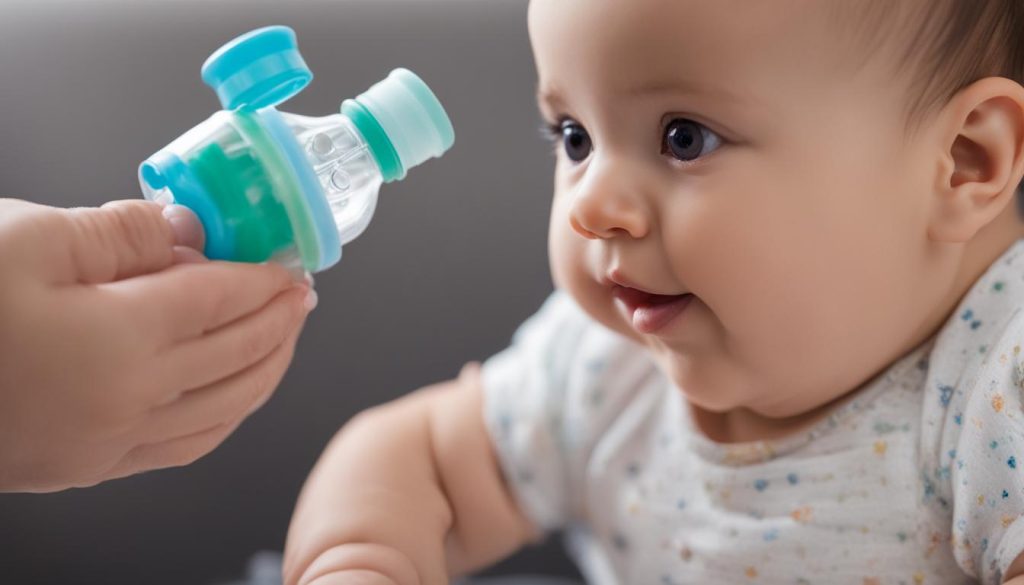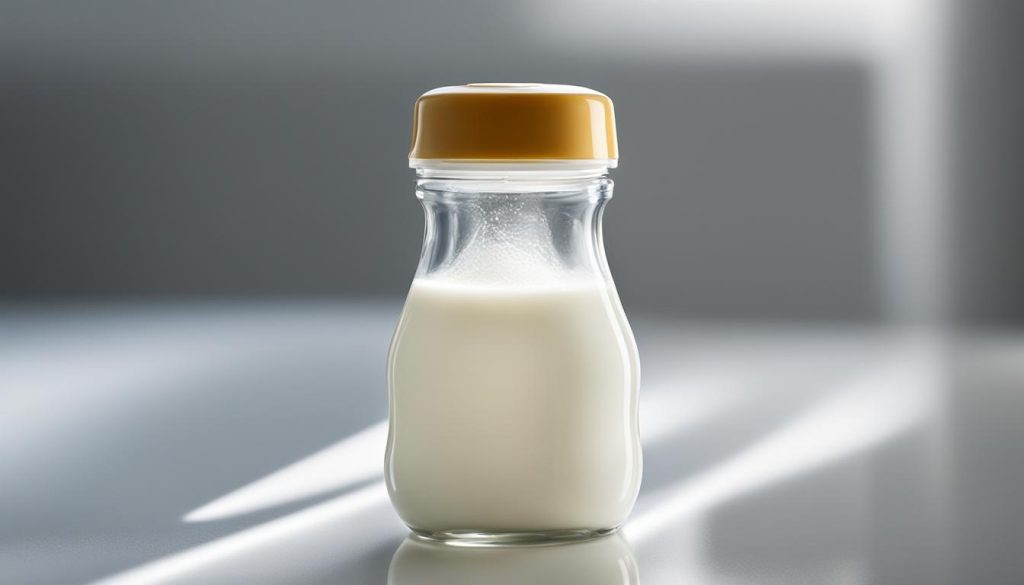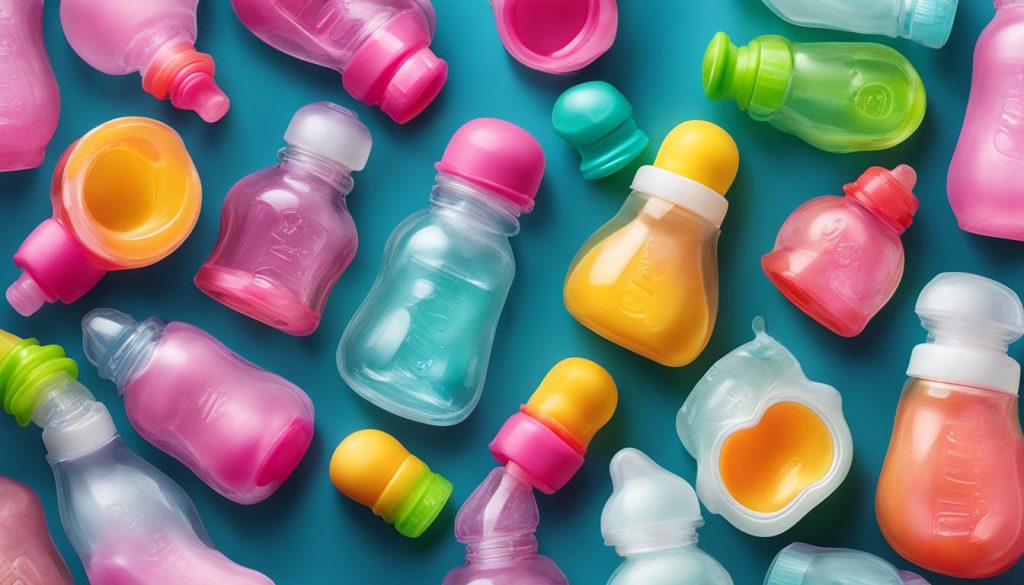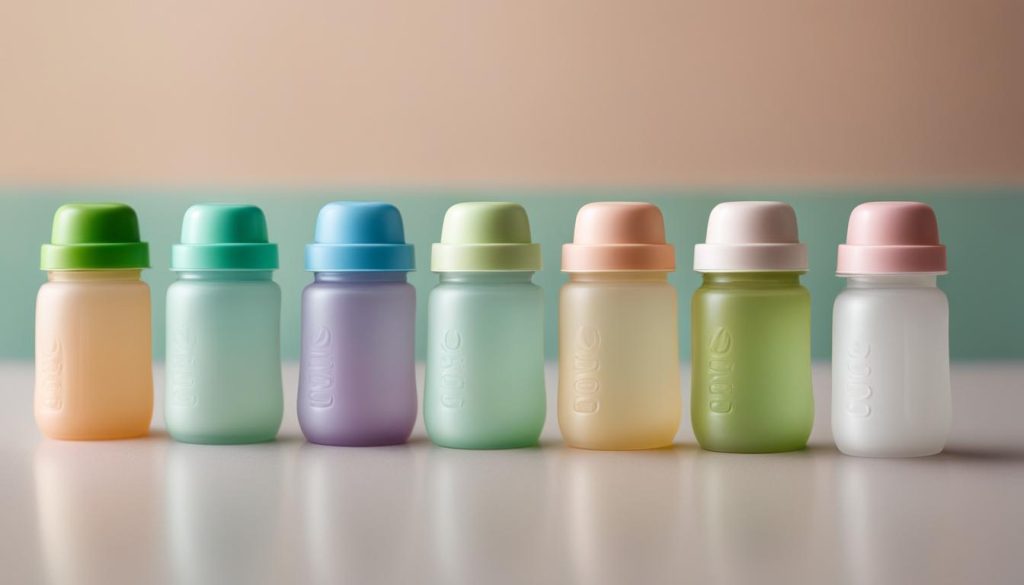Choosing the right nipple size for your 5-month-old baby is crucial for a comfortable and efficient feeding experience. Every baby has their own unique feeding style, so it’s important to pay attention to their cues and adjust accordingly. In this section, I will discuss the importance of selecting the correct nipple size, the various baby bottle nipple sizes available, and the factors to consider when choosing the best nipple size for a 5-month-old.
Before we dive into the details, let’s quickly explore the SEO relevant keywords for this section: what size nipple for 5-month-old, nipple size for 5-month-old baby, choosing the right nipple size, baby bottle nipple sizes, nipple sizes for 5-month-old, selecting the correct nipple size, nipple flow for 5-month-old, baby bottle nipple flow rates, nipple sizes for formula feeding, and best nipple size for 5-month-old.
Knowing when to change bottle nipple sizes can be confusing, as every baby has their own feeding style. Signs that it’s time to switch to a faster nipple flow include taking longer to finish eating, becoming fussy or irritable while eating, falling asleep during feeding, or exhibiting signs of gulping, hard swallowing, coughing, choking, milk dripping from the mouth, or refusing the bottle.
Dr. Brown’s offers a series of nipple levels for different feeding stages and styles, ranging from preemie nipple to level 4 nipple. The Y-Cut nipple is suitable for thicker liquids and cereals, while the Ultra-Preemie Nipple is designed for premature or medically fragile babies. It’s important to choose the right nipple size based on your baby’s individual needs and development.
The Importance of Baby Bottle Nipples in Infant Feeding
When it comes to infant feeding, baby bottle nipples play a crucial role in ensuring a comfortable and efficient feeding experience for your little one. The choice of nipple can greatly impact the flow rate of milk as well as the overall comfort and ease of feeding. It’s essential to choose the right nipple for your baby to promote healthy feeding habits and avoid unnecessary discomfort or frustration.
There are different materials commonly used for baby bottles, including glass, plastic, and silicone. Each material has its own advantages and considerations. Glass bottles are known for their durability, ease of cleaning, and being free from harmful chemicals. Plastic bottles, on the other hand, are lightweight and shatterproof, making them convenient for travel. Silicone bottles offer flexibility and are resistant to heat and chemicals.
When selecting a baby bottle nipple, it’s important to consider the material that works best for you and your baby. Some nipples are specifically designed to mimic the slower flow of breastfeeding, while others offer faster flow rates as your baby grows. Finding the right nipple size and type can help ensure a comfortable and efficient feeding experience for your little one.
“Choosing the right nipple size and material is essential for your baby’s comfort and proper feeding.”
The different types of baby bottle nipples include:
- Slow flow nipples: designed for newborns, mimicking the slower flow of breastfeeding.
- Medium flow nipples: slightly faster flow rates, suitable for babies who have outgrown slow flow.
- Fast flow nipples: for older babies who can handle a quicker milk flow.
- Variable flow nipples: allowing you to adjust the flow rate as needed.
- Wide-neck nipples: compatible with wide-neck bottles.
- Narrow nipples: designed for narrow bottles.
Choosing the right nipple size and material is essential for your baby’s comfort and proper feeding. It’s important to assess your baby’s feeding needs and observe their behavior during feeding to determine if a change in nipple size or type is necessary. Consulting with your pediatrician can also provide valuable guidance and support in selecting the most suitable nipple for your baby’s age and development.
Types of Baby Bottle Nipples
When it comes to baby bottle nipples, there are various types available to accommodate different feeding needs. Each type offers a unique design and flow rate to ensure a comfortable and efficient feeding experience for your little one.
Slow Flow Nipple
The slow flow nipple is specifically designed for newborns and is intended to mimic the slower flow of breastfeeding. It provides a gentle and controlled flow of milk, allowing babies to feed at their own pace.
Medium Flow Nipple
As your baby grows and becomes more accustomed to feeding, you may consider transitioning to a medium flow nipple. This type of nipple offers a slightly faster flow rate, suitable for babies who have outgrown the slow flow nipple.
Fast Flow Nipple
For older babies who can handle a quicker milk flow, fast flow nipples are available. These nipples allow for a faster and more efficient feeding experience, accommodating the growing needs of your little one.
Variable Flow Nipple
Unlike the other types, the variable flow nipple allows you to adjust the flow rate by simply turning the bottle. This flexibility is beneficial as it adapts to your baby’s changing needs throughout their feeding journey.
Wide-Neck Nipple
Wide-neck nipples are designed to be compatible with wide-neck bottles. They provide a broader and more natural shape, resembling the feel of a mother’s breast, which can be especially beneficial for babies transitioning between breastfeeding and bottle-feeding.
Narrow Nipple
On the other hand, narrow nipples are specifically designed for narrow bottles. They offer a more compact shape, making them suitable for on-the-go use and easy handling.
Tips on Bottle Maintenance and Sterilization for New Parents
Keeping your baby’s bottles clean and sterilized is essential for their health and well-being. Here are some helpful tips on bottle maintenance and sterilization for new parents:
- Cleaning baby bottles: After each use, wash the bottles with warm soapy water and rinse them thoroughly. Use a bottle brush to clean hard-to-reach areas and ensure all residue is removed. Pay close attention to the nipple and bottle cap, as milk can easily get trapped there.
- Sterilizing baby bottles: To sterilize the bottles, there are two common methods you can follow. The first is boiling the bottles and nipples in water for 5 minutes. Make sure to use a large pot with enough water to cover the bottles completely. The second method is using a steam sterilizer, which is a convenient option for busy parents. Follow the manufacturer’s instructions for proper usage.
- Additional tips: It’s important to regularly check for any signs of wear or damage in the bottles and nipples. If you notice any cracks, discoloration, or changes in the texture, it’s time to replace them. It’s also a good idea to air-dry the bottles and nipples after sterilization, as this helps prevent bacterial growth. Store the clean bottles and nipples in a clean, dry place to ensure they stay sanitary.
By following these bottle maintenance and sterilization tips, you can ensure that your baby’s feeding equipment is safe and hygienic. Remember, a clean bottle means a happy and healthy baby!
Comparing Materials Used in Baby Bottles: Glass, Plastic, Silicone
When it comes to choosing a baby bottle, there are different materials available, each with its own pros and cons. Here, I will compare the three most common materials used in baby bottles: glass, plastic, and silicone. Understanding the characteristics of each material can help you make an informed decision when selecting the right bottle for your baby.
Let’s start with glass baby bottles. Glass bottles are durable, easy to clean, and free from harmful chemicals. They are a great option if you prefer a non-toxic and eco-friendly choice. However, glass bottles may be heavier and more prone to breaking, so extra care is needed during handling and transportation.
Plastic baby bottles, on the other hand, are lightweight and shatterproof, making them convenient for on-the-go use. However, it’s important to choose BPA-free plastic bottles to avoid any potential health risks. While plastic bottles are generally durable, they may show signs of wear and tear over time.
Silicone baby bottles offer flexibility and are resistant to heat and chemicals. They are lightweight, easy to clean, and durable. Silicone is also a safe and non-toxic material. However, some parents may find that silicone bottles are not as widely available as glass or plastic options.
| Material | Pros | Cons |
|---|---|---|
| Glass | Durable and easy to clean | Heavier and more prone to breaking |
| Plastic | Lightweight and shatterproof | Potential health risks with certain plastics |
| Silicone | Flexible and resistant to heat and chemicals | May not be as widely available |
Ultimately, the choice of bottle material depends on your personal preferences, your baby’s needs, and your lifestyle. Consider the pros and cons of each material and select the one that suits you and your baby best. Remember to prioritize safety, hygiene, and ease of use when making your decision.
Choosing the Right Nipple Size for 5 Month Old Babies
When it comes to feeding your 5 month old baby, choosing the right nipple size is crucial for their comfort and nourishment. As babies grow and develop, their feeding preferences and abilities change, and it’s important to adjust the nipple size accordingly.
Signs that it may be time to switch to a larger nipple size include your baby taking longer to finish their bottle, becoming fussy or irritated during feedings, and falling asleep while still hungry. These signs indicate that your baby may need a faster flow to keep up with their growing appetite.
Dr. Brown’s offers a range of nipple levels to accommodate different feeding stages and styles. From preemie nipple to level 4 nipple, each level provides a different flow rate to meet your baby’s needs. Higher level nipples are suitable for older babies who can handle a faster flow of milk.
| Nipple Level | Flow Rate | Age Range |
|---|---|---|
| Level 1 | Slow flow | Newborn |
| Level 2 | Medium flow | 3+ months |
| Level 3 | Fast flow | 6+ months |
| Level 4 | Variable flow | 9+ months |
It’s important to observe your baby’s feeding behavior and adjust the nipple size accordingly. Remember, every baby is different, and their needs may vary. By choosing the right nipple size and flow rate, you can ensure a comfortable and enjoyable feeding experience for your little one.
Summary:
- Choosing the right nipple size is important for the comfort and nourishment of your 5 month old baby.
- Signs that it may be time to switch to a larger nipple size include taking longer to finish the bottle, becoming fussy or irritated during feedings, and falling asleep while still hungry.
- Dr. Brown’s offers a range of nipple levels with different flow rates to meet your baby’s needs.
- Observing your baby’s feeding behavior and adjusting the nipple size accordingly is key to ensuring a comfortable feeding experience.
Expert Advice on Age-Appropriate Feeding for Babies
When it comes to age-appropriate feeding for babies, it’s important to seek expert advice to ensure your little one’s nutritional needs are met. Every baby is unique, and their feeding requirements can vary based on factors such as age, development, and individual preferences. Following expert guidance can help you navigate the different stages of feeding and make informed decisions that support your baby’s growth and development.
Feeding guidelines for babies provide recommendations for different ages and can help you introduce new foods and adjust feeding routines as your baby grows. Pediatricians can offer valuable insights on when to start solid foods, how to transition from breastmilk or formula, and what foods to introduce first. They can also provide guidance on the appropriate portion sizes and ensure that your baby is receiving a balanced diet.
Expert advice on baby feeding can also address common concerns and challenges that parents may encounter. Whether it’s dealing with feeding difficulties, allergies, or introducing new textures, seeking guidance from professionals can provide reassurance and support. They can offer practical tips and strategies to make feeding a positive and enjoyable experience for both you and your baby.
“Feeding guidelines for babies provide recommendations for different ages and can help you introduce new foods and adjust feeding routines as your baby grows.”
Remember that every baby is unique, and it’s important to trust your instincts as a parent while also seeking professional advice. Your baby’s healthcare provider can provide personalized recommendations based on your baby’s individual needs and circumstances. Regular check-ups and consultations can ensure that your baby is on track with their feeding journey and thriving.
| Age | Feeding Recommendations |
|---|---|
| 0-6 months | Exclusive breastfeeding or formula feeding |
| 6-8 months | Introduction of pureed fruits, vegetables, and cereals |
| 8-10 months | Introduction of mashed or soft foods, including proteins and grains |
| 10-12 months | Gradual transition to family foods, chopped into small pieces |
Always consult with your pediatrician before introducing new foods or making any significant changes to your baby’s feeding routine. They can provide the most accurate and up-to-date information based on your baby’s individual needs and any specific health considerations.
Conclusion: Ensuring Age-Appropriate Feeding for Your 5 Month Old
In conclusion, providing age-appropriate feeding for your 5 month old is crucial for their growth and development. One important aspect is choosing the right nipple size for your baby. Pay attention to signs such as fussiness, falling asleep during feeding, or difficulty swallowing, as they may indicate the need for a faster flow nipple. By selecting an appropriate nipple size, you can ensure a comfortable and efficient feeding experience for your little one.
Equally important is maintaining and sterilizing baby bottles correctly. Regularly washing bottles with warm soapy water and using bottle brushes to clean hard-to-reach areas helps prevent the growth of harmful bacteria. Sterilizing the bottles and nipples through boiling or using a steam sterilizer further ensures your baby’s safety. Proper bottle maintenance and sterilization are essential for a healthy feeding routine.
For expert advice on age-appropriate feeding, consult with a pediatrician. They can provide valuable guidance on feeding milestones, introducing solid foods, and transitioning to different nipple sizes. Following expert advice offers peace of mind and ensures your baby’s feeding journey aligns with their developmental needs.
Remember, age-appropriate feeding involves choosing the right nipple size, maintaining and sterilizing bottles correctly, and seeking expert advice when needed. By prioritizing your baby’s feeding needs, you can create a safe, comfortable, and enjoyable feeding experience that supports their overall well-being.
FAQ
How do I know what size nipple is right for my 5 month old baby?
Signs that it’s time to switch to a faster nipple flow include taking longer to finish eating, becoming fussy or irritable while eating, falling asleep during feeding, or exhibiting signs of gulping, hard swallowing, coughing, choking, milk dripping from the mouth, or refusing the bottle.
What nipple sizes does Dr. Brown’s offer?
Dr. Brown’s offers a series of nipple levels for different feeding stages and styles, ranging from preemie nipple to level 4 nipple. The Y-Cut nipple is suitable for thicker liquids and cereals, while the Ultra-Preemie Nipple is designed for premature or medically fragile babies.
What materials are used for baby bottles?
Baby bottles are made of different materials, including glass, plastic, and silicone. Glass bottles are durable, easy to clean, and free from harmful chemicals. Plastic bottles are lightweight and shatterproof, while silicone bottles offer flexibility and resistance to heat and chemicals.
What types of baby bottle nipples are available?
There are different types of baby bottle nipples to accommodate various feeding needs. The most common types are slow flow nipples, medium flow nipples, fast flow nipples, variable flow nipples, wide-neck nipples, and narrow nipples. The choice depends on your baby’s age, feeding preferences, and bottle compatibility.
How do I maintain and sterilize baby bottles?
Baby bottles should be washed with warm soapy water after each use and thoroughly rinsed. Bottle brushes can be used for cleaning hard-to-reach areas. Sterilization can be done by boiling the bottles and nipples in water for 5 minutes or using a steam sterilizer. Follow the manufacturer’s instructions and regularly check for wear or damage in the bottles and nipples.
What are the pros and cons of different baby bottle materials?
Glass bottles are durable, easy to clean, and free from harmful chemicals. Plastic bottles are lightweight and shatterproof but may contain chemicals like BPA. Silicone bottles offer flexibility, resistance to heat and chemicals, and are lightweight and durable. Consider the pros and cons of each material to choose the right bottle for your baby.
When should I change the nipple size for my 5 month old?
It’s important to observe signs that your baby may need a faster flow nipple, such as taking longer to finish eating, becoming fussy or irritated while eating, and falling asleep during feeding. Dr. Brown’s offers a range of nipple levels suitable for older babies who can handle a faster flow of milk. Adjust the nipple size based on your baby’s feeding behavior.
Where can I find expert advice on age-appropriate feeding for my baby?
Consult with a pediatrician for valuable guidance on age-appropriate feeding, including introducing solid foods and transitioning to different nipple sizes. Following expert advice ensures your baby’s feeding journey is safe and enjoyable.




